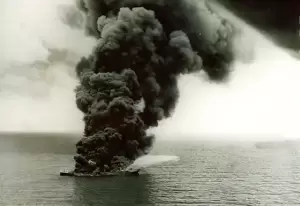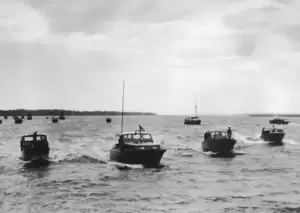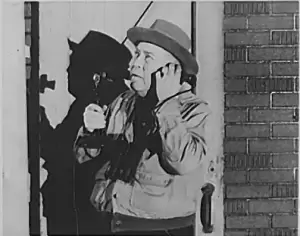Civil Defense: by Air and by Sea

The enemy’s visible presence offshore made the war quite real to Palm Beach County residents, who took an active part in the nation’s defense. Privately owned boats patrolled for submarines and rescued survivors from torpedoed ships, earning the nicknames, “Mosquito Fleet” and “Coastal Pickett Patrol.” Harvey E. Oyer, Jr., whose uncles were charter boat captains out of the Boynton Inlet, recalled that one of his uncles joined the Coast Guard the day after Pearl Harbor. His brothers did the same when he told them that anyone who enlisted their boat would be commissioned.
Frederick Voss, Oyer’s oldest uncle, was among those who quickly responded on May 9, 1942, when a German submarine torpedoed the MS Lubrafol, a Gulf Oil tanker interned by the War Shipping Administration and carrying heating oil. Although the ship was unable to transmit a distress call, two Coast Guard boats quickly arrived and towed the lifeboats clear of the burning ship. Of the 44 men aboard, 31 survived, including all six of the U.S. Naval Armed Guards on board. They were taken to a pavilion at the Boynton Inlet and surrounded by guards. Harvey Oyer, then 15 years old, rode over on his bicycle and listened to the naval guards recount their military exploits, while townspeople offered the men whiskey to calm their nerves.

The Coast Guard watched the skies as well as the ocean from observation towers every three miles along the coast in locations such as the Lake Worth Casino. If any kind of airplane was spotted, the watcher was to call the operator and say “Army-Flash” to generate an immediate collect call to the Army Filter Center. In West Palm Beach, residents took shifts as spotters for the Army Air Corps Aircraft Warning Service, scanning the skies for enemy warplanes from the roofs of tall office buildings.

At the time Gulf Stream, a tiny winter resort for the wealthy between Boynton Beach and Delray Beach, had world-class polo grounds, which the Coast Guard put to use. About 280 beach watchers lived in barracks and, armed with pistols and rifles, patrolled the beaches all night on horses shipped in from Kansas. Other observers served on the water—two Coast Guardsmen and two civilians on each boat—to watch for submarines and rescue survivors of attacks.

